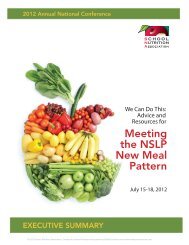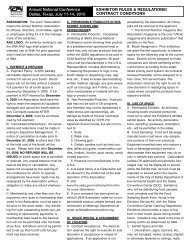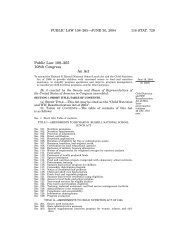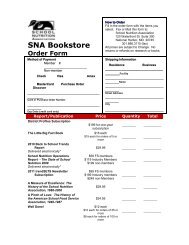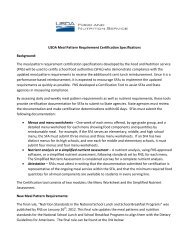Leadership Styles - School Nutrition Association
Leadership Styles - School Nutrition Association
Leadership Styles - School Nutrition Association
You also want an ePaper? Increase the reach of your titles
YUMPU automatically turns print PDFs into web optimized ePapers that Google loves.
What is Your<br />
<strong>Leadership</strong> Style?<br />
Attributes of Highly Effective<br />
Managers and Directors<br />
Diane Schweitzer, MA, SFNS, CFSP<br />
Dkschweitzer@Hammond.k12.in.us
Organizational Flow Chart<br />
Chiefs<br />
Indians
What would happen if<br />
there were too many chiefs<br />
and not enough Indians?
<strong>Styles</strong> of <strong>Leadership</strong><br />
• Autocratic<br />
• Democratic<br />
• Free Rein
Autocratic Style<br />
• Supervisor in charge gives orders and<br />
expects orders to be followed without<br />
question<br />
• Supervisor likes being in charge of<br />
subordinates<br />
• Supervisor likes having power and<br />
authority over others
Democratic<br />
Style<br />
• Supervisor is in charge, but employees<br />
have some say-so so in the decision-making<br />
process (consensus management)<br />
• Supervisor has final say, but willingly<br />
accepts opinions and feedback from<br />
employees in making final decision<br />
• Participative leadership style; employees<br />
are allowed to participate in management
Free Rein<br />
Style<br />
• Supervisor places a great deal of trust in<br />
employees to govern themselves with<br />
almost no supervision<br />
• Works best if employees are highly<br />
motivated, very knowledgeable and very<br />
skilled at their jobs
What Employees Need<br />
• Direction- Need to know where they’re<br />
supposed to go<br />
• Training- Need to know HOW to do the task<br />
and within parameters<br />
• Feedback from management with regard to<br />
decision-making abilities<br />
• Support from management- Time, materials,<br />
training<br />
• Patience and fairness
There needs to be balance<br />
between what employees<br />
need and want and the<br />
objectives of the<br />
organization
Examples of employee<br />
“wants” that may not be in<br />
management plans
Employees want:<br />
More money<br />
Less work<br />
Longer, more frequent breaks
Example: Employees may<br />
want more money but more<br />
money may not be<br />
in the budget
Douglas MacGregor’s Theory X<br />
• Employees hate work<br />
• Employees are lazy<br />
• Employees lack ambition<br />
• Employees cannot think<br />
• Employees must be controlled<br />
• Supervisors must give orders, employees<br />
must obey without question and without fail
MacGregor’s Theory Y<br />
• Employees like work<br />
• Employees know how to think and are<br />
creative and interested in their work<br />
• Employees can be self-governing if they are<br />
provided training<br />
• Employees actively seek responsibility
Abraham Maslow’s<br />
Hierarchy of Needs<br />
Self-Actualization<br />
Self-Esteem<br />
Social Needs<br />
Safety and Security<br />
Food, Shelter, Clothing, Sleep
Herzberg’s Motivators<br />
• Opportunity to learn something new (job<br />
challenges)<br />
• Opportunity for advancement<br />
• Recognition for a job well-done<br />
• These things keep an employee from becoming<br />
dissatisfied: : Good working conditions, job<br />
security, and money. These things are not motivators.<br />
• Money is not a job motivator
Expectancy Theory<br />
• Employees will work harder if they<br />
know there is opportunity for<br />
advancement<br />
• Advancement is expected to mean<br />
more opportunities for recognition<br />
(rewards, promotion, change in job<br />
title, a raise).
Positive/Negative Reinforcement<br />
• Positive reinforcement (rewards or<br />
recognition) leads to behavior that gets<br />
repeated<br />
• Negative reinforcement (punishment) leads<br />
to behavior that should slow down or stop
Think about various positive<br />
reinforcements (rewards) that<br />
can be used in the workplace
Delegating- The Pros<br />
• Jobs can be delegated, RESPONSIBILTY is not<br />
transferred. There is a difference between a JOB<br />
and a RESPONSIBILITY.<br />
• Productivity can be improved<br />
• Employee can feel job enrichment<br />
• Attitudes improve<br />
• Job skills improve<br />
• Increases employee morale
Delegating- The Cons<br />
• Employees aren’t ready to take on more<br />
responsibility (lack skills)<br />
• Productivity suffers (takes too much time).<br />
Supervisor would rather just do it herself.<br />
• Employee expects compensation when no<br />
compensation is provided<br />
• Supervisor does not want the subordinate to<br />
outshine her
Why Employees Don’t<br />
“Step up to the Plate”<br />
• Fear of appearing foolish or incompetent<br />
• No pay, no work<br />
• Lack skills<br />
• Lack confidence<br />
• Like things just as they are
Benefits of Conflict<br />
• Keeps the workplace interesting<br />
• Prevents boredom<br />
• Results in change to take place<br />
• Encourages communication at all levels by<br />
providing and analyzing information and differing<br />
points of view<br />
• Reinforces the work unit by expression of<br />
thoughts, ideas, opinions
Problems with Conflict<br />
• Productivity suffers- Too much time spent on<br />
emotions<br />
• Negative impact on the morale of the team<br />
• Disruption in service as a strong team may have<br />
weakened<br />
• Conflict may not necessarily be resolved quickly<br />
(smoldering fire)<br />
• Good employees may leave to avoid negative<br />
emotions
What Employees Want<br />
• Managers think:<br />
• 1. Good wages<br />
• 2. Job Security<br />
• 3. Promotion/Growth<br />
Opportunities<br />
• 4. Good working<br />
conditions<br />
• 5. Interesting work<br />
• Employees Say:<br />
• 1. Appreciation<br />
• 2. Feeling in the know<br />
• 3. Help with personal<br />
matters<br />
• 4. Job security<br />
• 5. Good wages
What Employees Want<br />
• Managers Think:<br />
• Employees Say:<br />
• 6. Interesting work<br />
• 6. Interesting Work<br />
• 7. Tactful discipline<br />
• 7. Promotion/Growth<br />
• 8. Appreciation for<br />
Opportunities<br />
work done<br />
• 8. Loyalty to workers<br />
• 9. Help with personal<br />
• 9. Good working<br />
problems<br />
conditions<br />
• 10. Being in the know • 10. Tactful discipline
<strong>Leadership</strong> Style<br />
• Have you been able to identify YOUR<br />
leadership style: Autocratic, Democratic,<br />
Free Rein?<br />
• How will you use this knowledge to be a<br />
better leader with YOUR employees?



